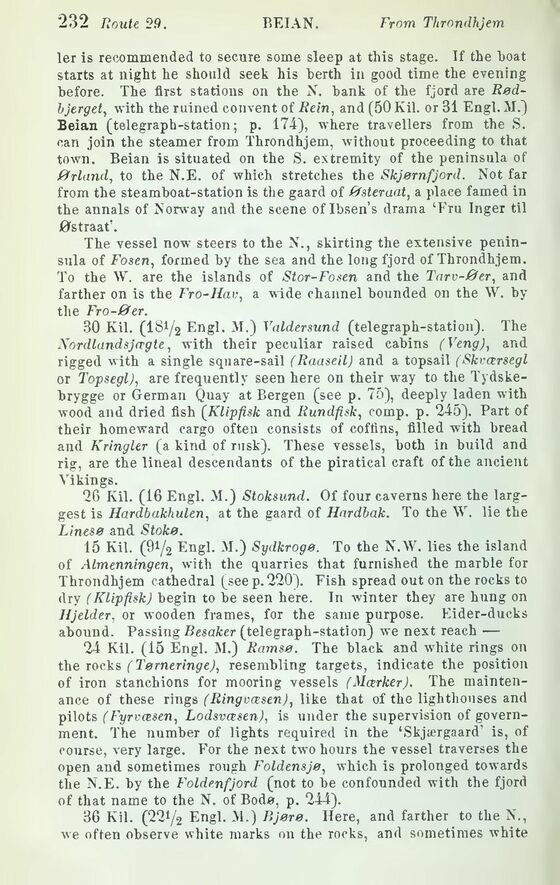
Full resolution (JPEG) - On this page / på denna sida - Norway - Pages ...

<< prev. page << föreg. sida << >> nästa sida >> next page >>
Below is the raw OCR text
from the above scanned image.
Do you see an error? Proofread the page now!
Här nedan syns maskintolkade texten från faksimilbilden ovan.
Ser du något fel? Korrekturläs sidan nu!
This page has never been proofread. / Denna sida har aldrig korrekturlästs.
ler is recommended to secme some sleep at this stage. If the boat
starts at night he should seek his berth in good time the evening
before. The first stations on the N. bank of the fjord are
Red-bjerget, with the rained convent of Rein, and (50 Kil. or 31 Engl. 31.)
Beian (telegraph-station; p. 174), where travellers from the S.
can join the steamer from Throndhjem, without proceeding to that
town. Beian is situated on the S. extremity of the peninsula of
Ørland, to the N.E. of which stretches the Skjernfjord. Not far
from the steamboat-station is the gaard of Østeraat, a place famed in
the annals of Norway and the scene of Ibsen’s drama ‘Fru Inger til
Østraat’.
The vessel now steers to the N., skirting the extensive
peninsula of Fosen, formed by the sea and the long fjord of Throndhjem.
To the W. are the islands of Stor-Fosen and the Tarv-0er, and
farther on is the Fro-Hav, a wide channel bounded on the W. by
the Fro-Øer.
30 Kil. (I8Y2 Engl. 31.) Valdersund (telegraph-station). The
Xordlandsjagte, with their peculiar raised cabins (Veng), and
rigged with a single square-sail (Raaseil) and a topsail (Skværsegl
or Topsegl), are frequently seen here on their way to the
Tydske-brygge or German Quay at Bergen (see p. 75), deeply laden with
wood and dried fish (Klipp.sk and Rundp.sk, comp. p. 245). Part of
their homeward cargo often consists of coffins, filled with bread
and Kringler (a kind of rusk). These vessels, both in build and
rig, are the lineal descendants of the piratical craft of the ancient
Vikings.
26 Kil. (16 Engl. 31.) Stoksund. Of four caverns here the
larg-gest is Hardbakhulen, at the gaard of Hardbak. To the |V. lie the
Lines0 and Stoke.
15 Kil. (9t/2 Engl. 31.) Sydkroge. To the IN. W. lies the island
of Almenningen, with the quarries that furnished the marble for
Throndhjem cathedral (seep.220). Eish spread out on the rocks to
dry (Klipfisk) begin to be seen here. In winter they are hung on
Iljelder, or wooden frames, for the same purpose. Eider-ducks
abound. Passing Besaker (telegraph-station) we next reach —
24 Kil. (15 Engl. 31.) Ramse. The black and white rings on
the rocks (Terneringe), resembling targets, indicate the position
of iron stanchions for mooring vessels (Marker). The
maintenance of these rings (Ringvcesen), like that of the lighthouses and
pilots (Fyrvcesen, Lodsvcesen), is under the supervision of
government. The number of lights required in the ‘Skjærgaard’ is, of
course, very large. For the next two hours the vessel traverses the
open and sometimes rough Foldensje, which is prolonged towards
the N.E. by the Foldenfjord (not to be confounded with the fjord
of that name to the N. of Bode, p. 244).
36 Kil. (221/2 Engl. 31.) Bjere. Here, and farther to the N.,
we often observe white marks on the rocks, and sometimes white
<< prev. page << föreg. sida << >> nästa sida >> next page >>